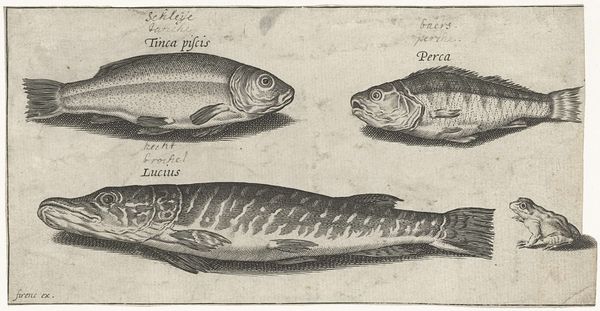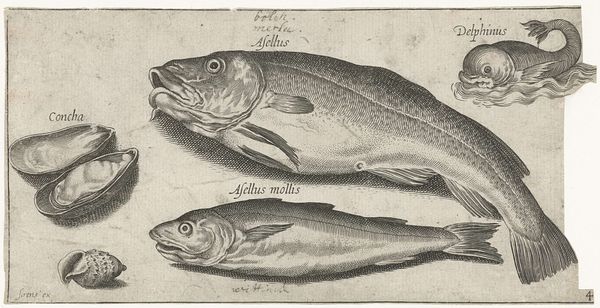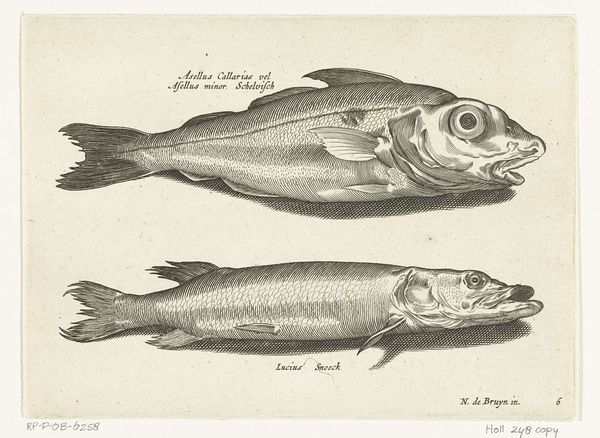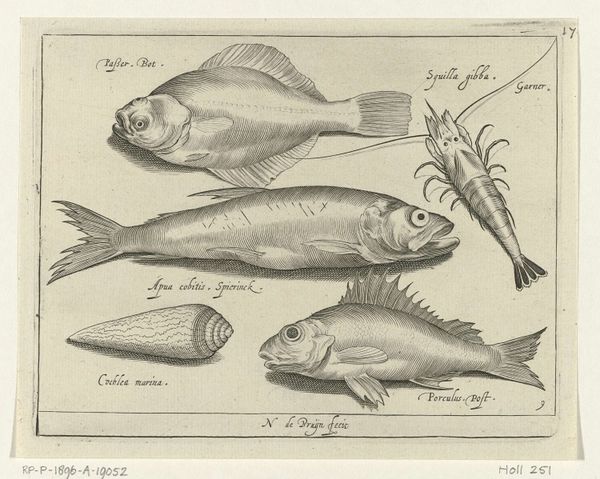
Twee vliegende knorhanen, lompje, harder, slijmvis en een onbekende vis 1600 - 1638
0:00
0:00
print, etching
#
dutch-golden-age
# print
#
etching
#
figuration
#
history-painting
#
realism
Dimensions: height 115 mm, width 180 mm
Copyright: Rijks Museum: Open Domain
Editor: We’re looking at "Twee vliegende knorhanen, lompje, harder, slijmvis en een onbekende vis," which translates to "Two flying gurnards, lumpsucker, grey mullet, blenny, and an unknown fish." It's an etching made sometime between 1600 and 1638 by Pierre Firens. What strikes me is the combination of realistic detail and the almost comical way these fish are presented. What do you make of it? Curator: It’s fascinating to consider this print within the context of the Dutch Golden Age. This was a period defined by burgeoning scientific inquiry, and art often served to document and categorize the natural world. We see this drive in the meticulous depiction of each fish species, including the attempt to label each specimen with descriptive, sometimes poetic names in Latin and Dutch, reflecting a culture eager to define and catalogue its world. Editor: So, it's less about artistic expression and more about scientific record-keeping? Curator: Not entirely. There's also the matter of cultural power at play. Who gets to define "knowledge?" How does this act of classifying and visually representing marine life contribute to the Dutch Republic's understanding and exploitation of its environment, especially its coastal resources? Note the term "Zee Zwaluwe" (sea swallow). This metaphorical language suggests that they see nature in terms of what they already know and understand from the land, superimposing that structure to create their vision of the sea. Editor: That's an interesting point – framing the ocean in familiar, land-based terms. How would this print have been circulated and received in its time? Curator: Prints like these were widely disseminated, circulating knowledge amongst different social groups, but often under the supervision and power structures of institutions. The very act of reproducing images like this, disseminating them, becomes part of solidifying that cultural understanding and Dutch control over this world. What do you take away from understanding its history? Editor: I initially saw a whimsical depiction of fish. Now I see a snapshot of a society striving to understand, and perhaps even control, the natural world through the lenses of their own cultural understanding and socio-political powers. Thanks for expanding my understanding! Curator: Absolutely, seeing art as both beautiful objects *and* artifacts of history always gives them new, powerful voices.
Comments
No comments
Be the first to comment and join the conversation on the ultimate creative platform.













